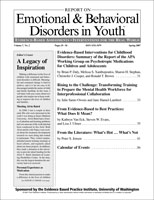Parental Help-Seeking Pathways and Perceived Effectiveness of Professional Sources for Hispanic and Non-Hispanic Families
Author: Beth Garland, Ph.D..; Steven Evans, Ph.D..; Jon Thompson, Ph.D..
Source: Volume 07, Number 03, Summer 2007 , pp.74-78(5)

< previous article |next article > |return to table of contents
Abstract:
Child behavior problems are commonly reported difficulties within the mental health and education communities. Problem behavior, especially beginning in early development, may escalate to deviant and harmful behaviors that affect a child’s home life, academic success, and relations with family and peers. However, one major barrier to children receiving mental health services is the caregiver’s perceptions and familiarity with help-seeking pathways, including professional sources of help. This pattern of help-seeking behavior has been shown to vary among families from different cultural backgrounds (Cauce et al., 2002), as well as for families with varying socioeconomic levels. Improving access to care for children requires that we improve our understanding of the process by which parents come to take their child for mental health care. This pilot study specifically addresses the final stages of the help-seeking process pertaining to the barriers to care and the selection of the source of assistance for Hispanic and low-income families. Mental health help-seeking behavior for both adults and adolescents has been described in four interrelated stages: Recognizing the problem; Deciding to seek or not seek help; Overcoming barriers to seeking help; and Selecting a source of help.Keywords:
Affiliations:
1: Department of Psychiatry at Baylor College of Medicine; 2: James Madison University; 3: James Madison University.